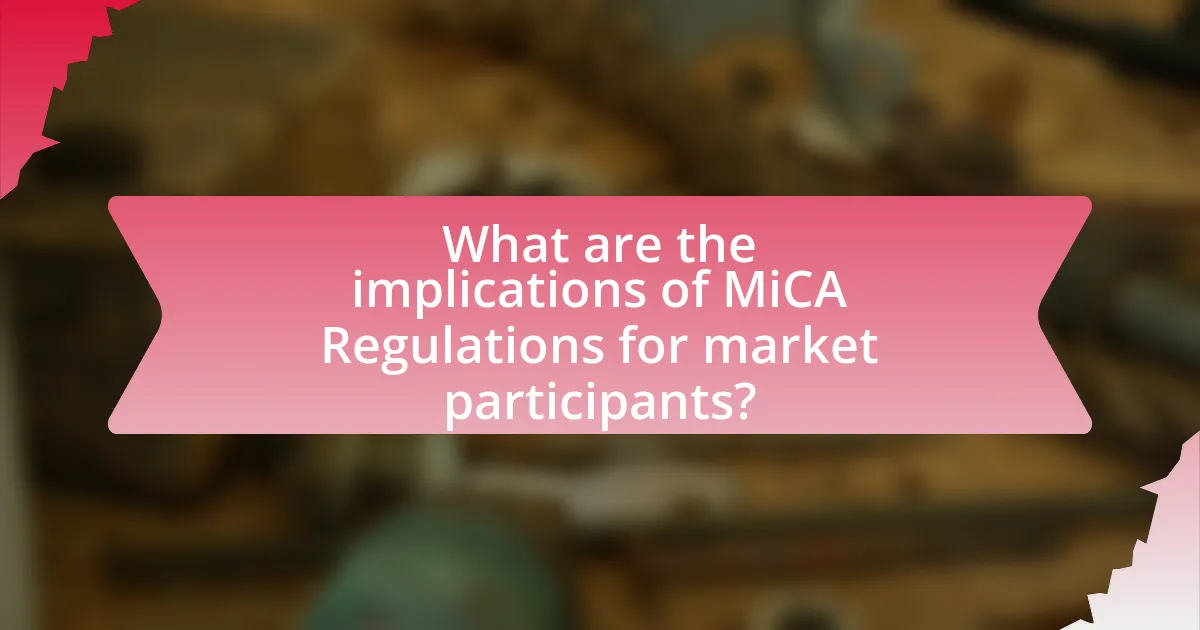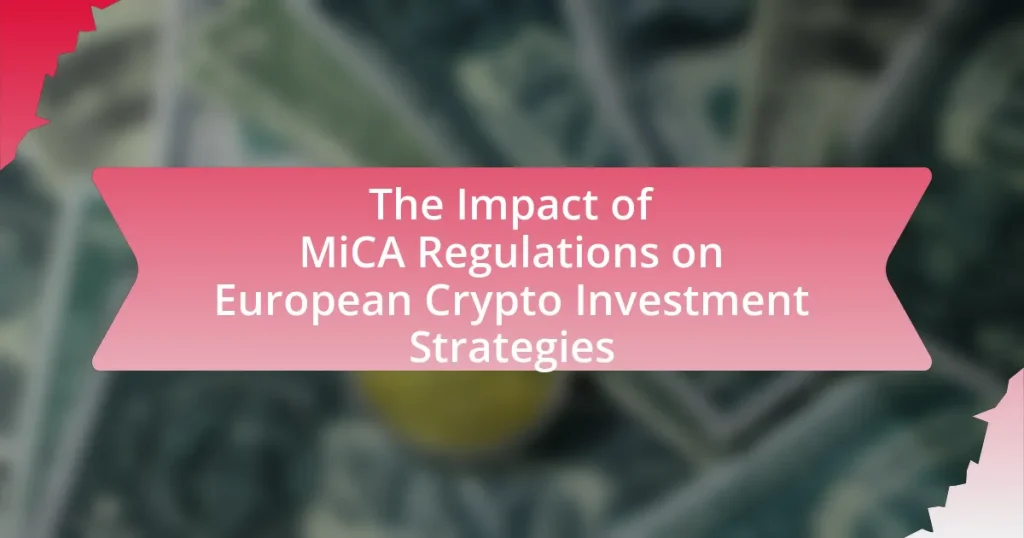The Markets in Crypto-Assets (MiCA) Regulations represent a significant legislative framework established by the European Union to regulate the cryptocurrency market. These regulations aim to enhance consumer protection, ensure market integrity, and foster innovation by providing legal clarity and consistent standards across EU member states. Key components include licensing requirements for crypto service providers, transparency mandates for token offerings, and specific classifications for different types of crypto-assets. The implementation of MiCA is expected to influence European crypto investment strategies by attracting institutional investors, promoting compliance, and mitigating risks associated with fraud and market volatility, ultimately shaping the future of the crypto ecosystem in Europe.

What are MiCA Regulations and their Purpose?
MiCA Regulations, or the Markets in Crypto-Assets Regulations, are a comprehensive legislative framework established by the European Union to regulate the crypto-asset market. Their primary purpose is to provide legal clarity and consumer protection in the rapidly evolving digital asset landscape, ensuring that crypto-assets are subject to consistent regulatory standards across EU member states. This framework aims to enhance market integrity, foster innovation, and mitigate risks associated with crypto-assets, such as fraud and market manipulation, thereby promoting a safer investment environment for consumers and institutional investors alike.
How do MiCA Regulations affect the cryptocurrency market?
MiCA Regulations significantly impact the cryptocurrency market by establishing a comprehensive legal framework for digital assets in the European Union. These regulations aim to enhance consumer protection, ensure market integrity, and promote innovation within the crypto sector. For instance, MiCA mandates that cryptocurrency service providers obtain licenses, which fosters trust and accountability among users. Additionally, the regulations require transparency in token offerings and impose strict rules on stablecoins, thereby reducing risks associated with market volatility. The implementation of MiCA is expected to attract institutional investors, as the regulatory clarity can lead to increased participation in the cryptocurrency market.
What specific aspects of cryptocurrency does MiCA regulate?
MiCA regulates several specific aspects of cryptocurrency, including the issuance and provision of services related to crypto-assets, stablecoins, and the operation of crypto exchanges. The regulation establishes a comprehensive framework for the authorization and supervision of crypto-asset service providers, ensuring they comply with transparency, consumer protection, and anti-money laundering requirements. MiCA also addresses the legal status of various types of crypto-assets, such as utility tokens and asset-referenced tokens, providing clarity on their classification and the obligations of issuers. This regulatory framework aims to enhance market integrity and foster innovation within the European crypto market.
How do MiCA Regulations aim to enhance investor protection?
MiCA Regulations aim to enhance investor protection by establishing a comprehensive legal framework for cryptocurrency markets in the European Union. This framework includes requirements for transparency, such as mandatory disclosures from crypto asset service providers regarding risks and fees, which helps investors make informed decisions. Additionally, MiCA introduces licensing requirements for service providers, ensuring that only compliant entities operate in the market, thereby reducing the risk of fraud. The regulations also include provisions for safeguarding consumer funds and implementing measures against market manipulation, further bolstering investor confidence.
What are the key components of MiCA Regulations?
The key components of the MiCA Regulations include the establishment of a comprehensive regulatory framework for crypto-assets, the classification of different types of crypto-assets, and the introduction of licensing requirements for crypto service providers. MiCA aims to enhance consumer protection, ensure market integrity, and promote innovation within the European Union’s digital finance landscape. Specifically, it categorizes crypto-assets into three main types: asset-referenced tokens, e-money tokens, and utility tokens, each with distinct regulatory requirements. Additionally, MiCA mandates that crypto service providers, such as exchanges and wallet providers, obtain authorization from national authorities, thereby fostering a safer investment environment.
What types of crypto assets are covered under MiCA?
The Markets in Crypto-Assets Regulation (MiCA) covers several types of crypto assets, specifically including cryptocurrencies, stablecoins, and utility tokens. Cryptocurrencies are defined as digital currencies that use cryptography for security and operate on decentralized networks. Stablecoins are digital assets pegged to stable assets like fiat currencies to minimize volatility. Utility tokens provide access to a product or service within a blockchain ecosystem. MiCA aims to create a comprehensive regulatory framework for these assets, ensuring investor protection and market integrity within the European Union.
How does MiCA define the roles of crypto service providers?
MiCA defines the roles of crypto service providers by categorizing them into specific functions such as offering crypto-asset services, managing crypto-asset portfolios, and providing custody services. These roles are essential for ensuring compliance with regulatory standards and protecting investors. The regulation mandates that service providers must obtain authorization from relevant authorities, adhere to operational requirements, and implement measures to mitigate risks associated with crypto transactions. This structured approach aims to enhance transparency and security in the crypto market, thereby fostering investor confidence and market integrity.

How will MiCA Regulations influence European Crypto Investment Strategies?
MiCA Regulations will significantly influence European crypto investment strategies by providing a clear legal framework that enhances investor protection and market integrity. This regulatory clarity will likely attract institutional investors who have previously been hesitant due to the lack of oversight in the crypto market. For instance, the introduction of standardized rules for crypto asset service providers will reduce risks associated with fraud and market manipulation, thereby fostering a more stable investment environment. Additionally, the requirement for transparency and compliance will encourage companies to adopt best practices, further legitimizing the crypto sector in Europe. As a result, these regulations are expected to lead to increased investment flows and a more mature market landscape.
What changes can investors expect in their investment strategies?
Investors can expect significant changes in their investment strategies due to the implementation of MiCA regulations, which aim to provide a comprehensive framework for cryptocurrency markets in Europe. These regulations will likely lead to increased compliance requirements, prompting investors to prioritize assets that adhere to regulatory standards, thereby reducing exposure to non-compliant cryptocurrencies. Additionally, the introduction of consumer protection measures and enhanced transparency will encourage investors to adopt more cautious and informed approaches, focusing on projects with clear governance and operational frameworks. Historical data indicates that regulatory clarity often stabilizes markets; for instance, after the introduction of the SEC’s regulations in the U.S., there was a marked increase in institutional investment in compliant assets.
How will compliance requirements impact investment decisions?
Compliance requirements will significantly impact investment decisions by increasing the regulatory burden on investors and influencing their risk assessments. As the Markets in Crypto-Assets (MiCA) regulations are implemented, investors will need to ensure that their strategies align with new legal frameworks, which may lead to a preference for compliant assets over those that are not. This shift is evidenced by the fact that regulatory clarity often attracts institutional investors, as seen in the aftermath of the SEC’s regulatory actions in the U.S., where compliance-driven investments surged. Consequently, the MiCA regulations are likely to steer capital towards projects that demonstrate adherence to compliance standards, ultimately shaping the landscape of European crypto investments.
What new opportunities may arise for investors under MiCA?
Under the Markets in Crypto-Assets (MiCA) regulation, new opportunities for investors include enhanced legal clarity and increased market participation. MiCA establishes a comprehensive regulatory framework for cryptocurrencies, which reduces uncertainty and risk for investors, thereby encouraging more institutional and retail participation in the crypto market. This regulatory clarity can lead to the development of new financial products and services, such as crypto exchange-traded funds (ETFs) and tokenized assets, which can attract a broader range of investors. Additionally, the harmonization of regulations across EU member states can facilitate cross-border investments, allowing investors to access a wider array of crypto assets and markets.
How will MiCA affect the risk landscape for crypto investments?
MiCA will reduce the risk landscape for crypto investments by establishing a comprehensive regulatory framework that enhances transparency and consumer protection. This regulation mandates that crypto asset service providers adhere to strict operational standards, including capital requirements and risk management protocols, which aim to mitigate fraud and market manipulation. For instance, MiCA requires issuers of stablecoins to maintain sufficient reserves, thereby increasing investor confidence and reducing the likelihood of sudden market crashes. Additionally, the regulation promotes accountability by enforcing compliance measures, which can lead to a more stable and trustworthy investment environment.
What risks are mitigated by the implementation of MiCA?
The implementation of the Markets in Crypto-Assets (MiCA) regulation mitigates several key risks associated with cryptocurrency investments. Primarily, it addresses the risks of market manipulation and fraud by establishing clear guidelines for transparency and accountability among crypto asset service providers. MiCA requires these entities to disclose essential information, thereby reducing the likelihood of misleading practices that can harm investors. Additionally, MiCA enhances consumer protection by ensuring that crypto assets meet specific standards, which helps to safeguard investors from potential losses due to inadequate security measures or operational failures. Furthermore, the regulation aims to reduce systemic risks in the financial system by promoting a more stable and regulated environment for crypto assets, thus fostering greater confidence among investors.
How might new risks emerge as a result of MiCA Regulations?
New risks may emerge as a result of MiCA Regulations due to increased regulatory scrutiny and compliance requirements for crypto assets. As these regulations impose stricter guidelines on issuers and service providers, there is a potential for operational risks, including the inability to meet compliance standards, which could lead to penalties or market exit. Additionally, the introduction of standardized frameworks may inadvertently stifle innovation, causing firms to become overly cautious and limiting the development of new financial products. Historical examples, such as the impact of the GDPR on tech companies, illustrate how stringent regulations can create unforeseen challenges in adapting business models, leading to increased costs and reduced competitiveness in the market.

What are the implications of MiCA Regulations for market participants?
The implications of MiCA Regulations for market participants include enhanced regulatory clarity and compliance requirements for cryptocurrency operations within the European Union. Market participants must adhere to new licensing obligations, which necessitate obtaining authorization from relevant authorities to operate legally. This regulatory framework aims to protect investors and ensure market integrity by imposing standards for transparency, disclosure, and consumer protection. For instance, the regulations require issuers of crypto assets to publish a white paper detailing the project, which must be approved by regulators, thereby increasing accountability. Additionally, MiCA introduces provisions for stablecoins, mandating that they maintain sufficient reserves and comply with strict operational guidelines. These changes are expected to foster a more secure investment environment, potentially attracting institutional investors who prioritize regulatory compliance.
How will MiCA Regulations impact institutional investors?
MiCA Regulations will enhance the regulatory framework for institutional investors in the cryptocurrency market, providing greater legal clarity and investor protection. By establishing a comprehensive set of rules governing crypto assets, MiCA aims to reduce risks associated with market volatility and fraud, which are significant concerns for institutional investors. The regulations will require firms to adhere to strict compliance measures, including transparency in operations and the safeguarding of client assets, thereby fostering a more secure investment environment. This structured approach is expected to attract more institutional capital into the crypto space, as evidenced by the increasing interest from major financial institutions in regulated markets.
What strategies should institutional investors adopt in response to MiCA?
Institutional investors should adopt a proactive compliance strategy in response to the Markets in Crypto-Assets (MiCA) regulations. This involves aligning their investment frameworks with the regulatory requirements set forth by MiCA, which aims to create a unified regulatory environment for crypto assets in the European Union. By implementing robust risk management practices and ensuring transparency in their operations, institutional investors can mitigate potential legal and financial risks associated with non-compliance.
Additionally, they should invest in technology solutions that enhance reporting capabilities and facilitate adherence to MiCA’s disclosure requirements. According to the European Commission, MiCA is expected to provide legal clarity and foster innovation, which institutional investors can leverage to identify new investment opportunities within the regulated crypto market. By staying informed about ongoing regulatory developments and engaging with policymakers, institutional investors can also influence the regulatory landscape to better suit their investment strategies.
How will MiCA influence the behavior of retail investors?
MiCA will influence the behavior of retail investors by providing a clearer regulatory framework for cryptocurrency investments, which enhances investor confidence. This regulation aims to protect investors through transparency and accountability measures, such as requiring issuers to provide detailed information about their crypto assets. As a result, retail investors are likely to engage more actively in the market, knowing that there are safeguards in place to mitigate risks associated with fraud and market manipulation. The European Securities and Markets Authority (ESMA) has indicated that such regulations can lead to increased participation from retail investors, as they feel more secure in their investment choices.
What are the potential long-term effects of MiCA on the crypto ecosystem?
The potential long-term effects of MiCA on the crypto ecosystem include increased regulatory clarity, enhanced investor protection, and the promotion of market stability. MiCA, or the Markets in Crypto-Assets regulation, aims to create a comprehensive regulatory framework for cryptocurrencies in the European Union, which can lead to greater institutional investment as firms gain confidence in compliance. This regulatory clarity may also reduce fraud and market manipulation, fostering a safer environment for retail investors. Furthermore, by establishing standards for crypto assets, MiCA can encourage innovation while ensuring that projects adhere to safety and transparency requirements, ultimately contributing to a more robust and sustainable crypto market.
How might MiCA shape the future of crypto innovation in Europe?
MiCA, or the Markets in Crypto-Assets regulation, is likely to significantly shape the future of crypto innovation in Europe by providing a clear regulatory framework that fosters investor protection and market integrity. This regulation aims to create a unified approach across EU member states, which can enhance legal certainty for businesses and investors involved in crypto assets. By establishing guidelines for the issuance and trading of cryptocurrencies, MiCA encourages innovation while ensuring compliance with financial regulations. The European Commission estimates that a well-regulated crypto market could attract more institutional investment, potentially increasing the overall market capitalization of crypto assets in Europe.
What role will MiCA play in fostering market stability?
MiCA will play a crucial role in fostering market stability by establishing a comprehensive regulatory framework for cryptocurrencies in the European Union. This framework aims to enhance transparency, reduce risks associated with market manipulation, and protect investors, thereby creating a more secure environment for crypto transactions. For instance, MiCA mandates that crypto asset service providers adhere to strict operational standards and conduct thorough due diligence, which can mitigate the volatility often seen in unregulated markets. Additionally, by providing clear guidelines on the issuance and trading of crypto assets, MiCA helps to build investor confidence, which is essential for market stability.
What best practices should investors follow in light of MiCA Regulations?
Investors should prioritize compliance with MiCA Regulations by ensuring that their crypto assets are registered and adhere to the regulatory framework. This includes conducting thorough due diligence on the projects they invest in, verifying that these projects comply with MiCA’s requirements for transparency and consumer protection. Additionally, investors should stay informed about ongoing regulatory updates and engage with legal experts to navigate the evolving landscape effectively. By following these practices, investors can mitigate risks associated with non-compliance and enhance their investment strategies in the European crypto market.















